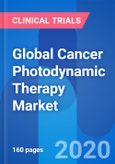"Global Cancer Photodynamic Therapy Market & Clinical Trial Insight 2026" Report Highlights:
- Global Cancer Photodynamic Therapy Market Opportunity: > US$ 4 Billion
- Share of Cancer in Photodynamic Therapy: > 40%
- US To Dominate Global Photodynamic Therapy Market
- Global Cancer Photosensitisers Clinical Pipeline: >10 Photosensitisers In Trials
- Marketed Cancer Photosensitisers: >5
- US Dominating Global Clinical Trials Landscape: >10 Photosensitisers In Trials
The research report “Global Cancer Photodynamic Therapy Market & Clinical Trial Insight 2026” represents an interpretation of ongoing trends and strategies of global photodynamic therapy market. The research report concentrates on providing the information about the present state of the therapy in the overall cancer market which will bring to our readers a deep and valuable insight about the current trends and the overall growth and strength of the therapy at regional and global level. The information presented in the report has been compiled and segmented to highlight the important achievements and the abilities of the market over the other cancer markets.
The therapy majorly focuses on the treatment of the cancer through the agents that are light sensitive. Since its entry in the cancer market, the therapy is observing a huge commercial success. Being a modern and non-invasive therapeutic modern method, the therapy is constantly adding the number of the patients it is treating. The major growth attributer for the market is the fact that the therapy is totally harmless and utilizes only a source of light for processing necrosis in cancer cells.
Cancer photodynamic therapy holds other additional benefits than the traditional cancer treatments like chemotherapy or surgery. The therapy gives an advantage for suitable mode of administration for the cancer agent, thus ignoring the other harmful scenarios that other therapies makes the cancer patient undergo. The agents involved in the therapy can be administered systematically as well as topically. This makes the therapy a priority among the cancer patients. On the basis of priority and the additional benefits the therapy provides, the market of the therapy has presented a scenario which is a boon for the pharmaceutical companies investing in the respective therapy.
Cancer photodynamic treatment is capable of destructing the cancer cells with just one source of light. This makes the treatment a modern, harmless and a convenient therapy. With so many expertise working on the therapy, so far they have discovered the potential outcomes of the therapy in several medical fields such as urology, cardiology, dentistry, immunology, ophthalmology and most importantly dermatology.
In addition to the benefits it has provided the cancer patients in the last few decades, the therapy is continuously being explored for rest of the cancer fields. The level of the successful cancer survival rates with the discovery of photodynamic therapy has experienced a major growth. The need of the effective cancer treatments has already pushed the researchers to think out of the box and photodynamic therapy out of all the other methodologies is a discovery that has gained enough appreciation in a short period of time. The urgency in reducing the cancer mortality rate and providing an effective yet harmless therapy is what will drive the market of the therapy in the future years.
Table of Contents
Samples

LOADING...
Companies Mentioned (Partial List)
A selection of companies mentioned in this report includes, but is not limited to:
- Ambicare Health
- Biofrontera AG
- Biolitec
- Coherent
- Dusa Pharmaceuticals
- Lumenis
- Nanoprobes
- PhotoMedex
- Photolitec
- Quest Pharma Tech
- Soligenix








